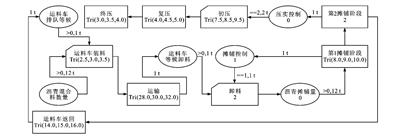| 基于离散事件模拟沥青路面施工对环境的影响 |
| |
| 引用本文: | 于斌, 孙悦. 基于离散事件模拟沥青路面施工对环境的影响[J]. 交通运输工程学报, 2018, 18(4): 12-21. doi: 10.19818/j.cnki.1671-1637.2018.04.002 |
| |
| 作者姓名: | 于斌 孙悦 |
| |
| 作者单位: | 东南大学交通学院, 江苏 南京 211189 |
| |
| 基金项目: | 国家自然科学基金项目51408114江苏省自然科学基金项目BK20171359教育部留学回国人员科研启动基金项目2015-1098 |
| |
| 摘 要: | 
为了降低沥青路面施工过程中能耗及温室气体和污染物排放, 建立了基于离散事件模拟的沥青路面施工环境影响计算模型, 利用概率分布函数和逻辑语句将施工步骤抽象化, 应用图形化离散事件模拟软件构建了沥青路面施工离散事件模型, 将Nonroad计算模型植入, 进行了不同温室气体和污染物的动态计算, 并对比了不同施工情况的模拟排放结果。分析结果表明: 运料车将沥青混合料运输至摊铺现场的过程为沥青路面施工的主要能耗源, 为总能耗的44%, 摊铺过程与运料车返回过程的能源消耗分别为总能耗的32%、12%;温室气体与污染物排放的主要施工步骤为运输和摊铺过程, 占排放总量的50%以上; 摊铺与压实过程产生的排放物主要为NOx, 运输过程产生的排放物主要为CO2; 对施工工艺进行调整, 使用不间断摊铺施工会明显减少NOx的排放, 减排量约为15%;在施工设备方面, 适当增大摊铺设备的容量会减少CO2和HC的排放, 前者减排量约为25%, 后者约为17%。
可见, 基于离散事件模拟沥青路面施工环境影响计算模型, 可量化沥青路面施工过程的能耗及温室气体和污染物排放, 优化沥青路面施工技术方案。

|
| 关 键 词: | 道路工程 沥青路面施工 环境影响 能耗 离散事件模拟 污染物排放 |
| 收稿时间: | 2017-12-19 |
| 本文献已被 CNKI 等数据库收录! |
| 点击此处可从《交通运输工程学报》浏览原始摘要信息 |
|
点击此处可从《交通运输工程学报》下载免费的PDF全文 |
|



